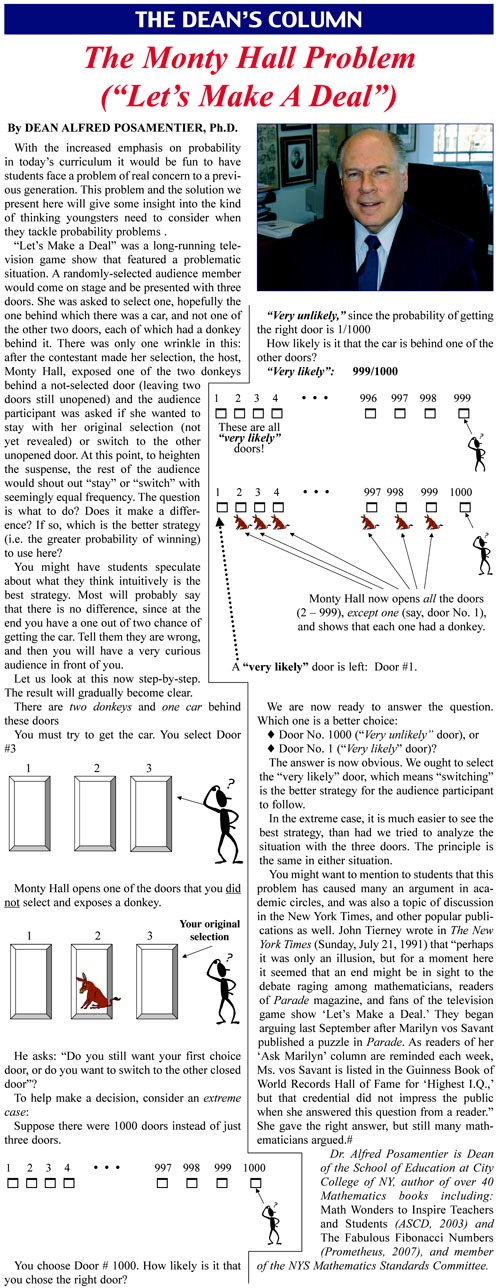
The Monty Hall Problem
(“Let’s Make A Deal”)
by Dean Alfred Posamentier, ph.D.
With the increased emphasis on probability in today’s curriculum it would be fun to have students face a problem of real concern to a previous generation. This problem and the solution we present here will give some insight into the kind of thinking youngsters need to consider when they tackle probability problems .
“Let’s Make a Deal” was a long-running television game show that featured a problematic situation. A randomly-selected audience member would come on stage and be presented with three doors. She was asked to select one, hopefully the one behind which there was a car, and not one of the other two doors, each of which had a donkey behind it. There was only one wrinkle in this: after the contestant made her selection, the host, Monty Hall, exposed one of the two donkeys behind a not-selected door (leaving two doors still unopened) and the audience participant was asked if she wanted to stay with her original selection (not yet revealed) or switch to the other unopened door. At this point, to heighten the suspense, the rest of the audience would shout out “stay” or “switch” with seemingly equal frequency. The question is what to do? Does it make a difference? If so, which is the better strategy (i.e. the greater probability of winning) to use here?
You might have students speculate about what they think intuitively is the best strategy. Most will probably say that there is no difference, since at the end you have a one out of two chance of getting the car. Tell them they are wrong, and then you will have a very curious audience in front of you.
Let us look at this now step-by-step. The result will gradually become clear.
There are two donkeys and one car behind these doors
You must try to get the car. You select Door #3
Monty Hall opens one of the doors that you did not select and exposes a donkey.
He asks: “Do you still want your first choice door, or do you want to switch to the other closed door”?
To help make a decision, consider an extreme case:
Suppose there were 1000 doors instead of just three doors.
You choose Door # 1000. How likely is it that you chose the right door?
“Very unlikely,” since the probability of getting the right door is 1/1000
How likely is it that the car is behind one of the other doors?
“Very likely”: 999/1000
We are now ready to answer the question. Which one is a better choice:
♦ Door No. 1000 (“Very unlikely” door), or
♦ Door No. 1 (“Very likely” door)?
The answer is now obvious. We ought to select the “very likely” door, which means “switching” is the better strategy for the audience participant to follow.
In the extreme case, it is much easier to see the best strategy, than had we tried to analyze the situation with the three doors. The principle is the same in either situation.
You might want to mention to students that this problem has caused many an argument in academic circles, and was also a topic of discussion in the New York Times, and other popular publications as well. John Tierney wrote in The New York Times (Sunday, July 21, 1991) that “perhaps it was only an illusion, but for a moment here it seemed that an end might be in sight to the debate raging among mathematicians, readers of Parade magazine, and fans of the television game show ‘Let’s Make a Deal.’ They began arguing last September after Marilyn vos Savant published a puzzle in Parade. As readers of her ‘Ask Marilyn’ column are reminded each week, Ms. vos Savant is listed in the Guinness Book of World Records Hall of Fame for ‘Highest I.Q.,’ but that credential did not impress the public when she answered this question from a reader.” She gave the right answer, but still many mathematicians argued.#
Dr. Alfred Posamentier is Dean of the School of Education at City College of NY, author of over 40 Mathematics books including: Math Wonders to Inspire Teachers and Students (ASCD, 2003) and The Fabulous Fibonacci Numbers (Prometheus, 2007), and member of the NYS Mathematics Standards Committee.
